More about Thimbles





Magdalena and William Isbister.
A thimble is really a cap of some material which is worn to cover or protect a finger from some potential damage or to facilitate some sort of procedure. Clearly thimbles for this type of use tend to be simple and adapted to the activity to be undertaken. We have been surprised to find that there were so many non-sewing uses of thimbles.
Adornment
In the Far East decorated Mandarin ‘nail guards’ are sometimes worn by dancers. They may be die-stamped (Fig 1), decorated with applied filigree, enamel and semi-precious stones (Fig 2), or possibly cast. They were made in the 19th century and today, many of these so called ‘nail guards’ have been converted into broaches by the addition of a pin on the back.
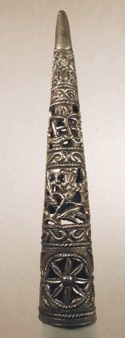
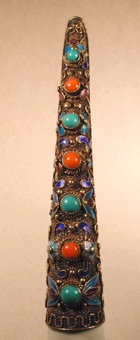

Fig 1 Fig 2
Agriculture
Potato pickers may use simple thimbles to protect the ends of their fingers whilst they sift through the loosened earth in order to find potatoes. Similarly, workers in the tobacco industry protect their fingers with a thimble during the stemming process which comprises the removal of all the stems from the tobacco leaves themselves.
In days past roof thatchers, in Norfolk, sometimes wore a thimble to protect their fingers. It was quite crudely made and had a sharply formed top (Fig 3). Thatchers today do not seem to use thimbles in their trade.

Fig 3
In the 18th century women and children worked splitting straw in order to make hats, baskets etc. The split straw was plaited and then sewn. A small hooked tool (Fig 4) was used to split the stem and because the stem may be very sharp and damaging to the fingers, and the plaited straw had to be sewn, thimbles were worn by the workers (1). These thimbles found with the straw splitting instrument were often of a very small size (1.2 and 1.7 cm. in height) indicating that the workers were probably rather young.
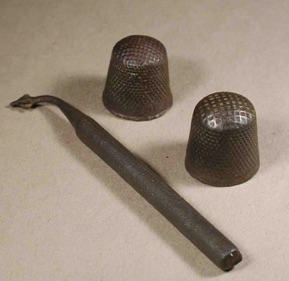
Fig 4
Farm laborers who cut up haystacks and in so doing frequently drive fragments of straw under their nails sometimes wear leather thimbles when thrusting their hands through the stacks (2).
Cartridge caps
Cossack soldiers wear bands of powder holders on their chests (Fig 5) as part of their traditional uniform. The powder holders appear to be closed by thimbles.

Fig 5
The decorated niello caps are often thought to be thimbles (Fig 6), and clearly the one on the right would have been very suitable for use as a thimble.


Fig 6
Whether similarly shaped niello inlaid thimbles were ever actually made remains a mystery. There can be no doubt that some of these objects would be quite unsuitable for sewing because they are smooth or their tops are so shaped as to make needle pushing impossible (Fig 7).
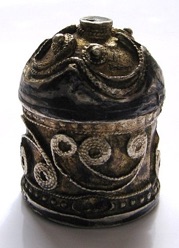
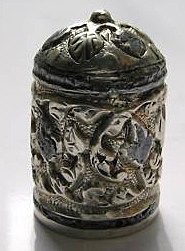
Fig 7
McConnel argues that the ‘cap’ thimbles are shorter, but decorated in a similar manner (3) to the powder container caps. Whether any of these objects were specifically made to push needles and are thus properly termed thimbles can not now be determined but what ever they were made for they were used by Ukrainian women for sewing so that many are truly used as thimbles even if they were not made as thimbles.
Surgery
Some surgeons have, in the past (4), actually used thimbles for sewing but the days of straight needles and ‘hand sewing’ as opposed to using a needle in a needle holder have all but disappeared. The use of thimbles for their intended function has thus virtually ceased. Thimbles or thimble derivatives have in the past or still are being used in other surgical situations.
Cardiac Surgery
In the 50s, a cardiac surgeon, William Glenn (5), described the use of a tailor’s type of thimble (Fig 8) to dilate or split one of the heart valves during open heart surgery.
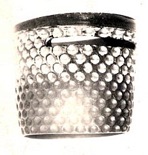
Fig 8
Patients with severe Mitral valve stenosis sometimes need surgery and when the valve is exposed it is found that the cusps of the valve are frequently very firmly stuck together. The stuck valve cusps can either be separated by blunt finger force, pushing a finger through the valve and breaking down the adhesions (so called ‘finger fracture’), or sharp dissection but the latter method may result in valvular insufficiency post operatively. In order to facilitate this process, Glenn described the use of a thimble which was worn on the first finger of the operator’s hand. This technique had the additional advantage of size standardisation as the thimble size remained constant. So as to prevent loss of the thimble in the heart if it stuck in or below the valve, the thimble was worn on the finger with tapes looped around the thimble under the surgeon’s glove (Fig 9). If there were any problems with thimble or finger extraction an assistant could pull on the tapes and free the thimble-finger combination. In his first series Glenn reported 250 patients in whom the thimble had been used as a valve dilator with good results.
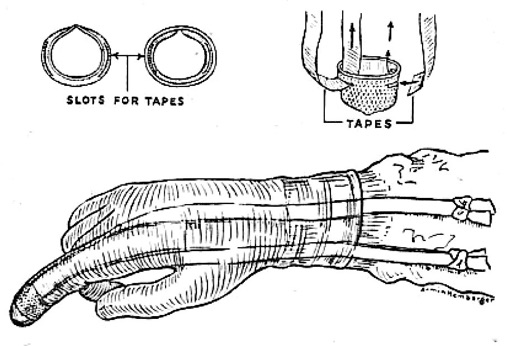
Fig 9
Ear, nose and throat (ENT) surgery
Finger protectors (Fig 10) are used in ENT surgery to prevent accidental biting injury during intra oral procedures. They might also have been used in epileptic patients by staff trying to secure an oral airway during a fit.

Fig 10
In 1906, Cresswell Baber (6) described the problem of making surgical mops for ear, nose, and throat work by holding the cotton wool between the finger and thumb. This necessitated repeated washing of the fingers and to avoid this inconvenience and potential source of infection he had metal thimbles made for the left forefinger and thumb (Fig 11). They were flattened, and provided with several shallow and one deeper groove on the opposing surfaces, where also the metal was dulled instead of being polished. According to Cresswell Baber, ‘with a little practice mops of any size can be rapidly made’. The thimbles fitted on to a metal stand and could be boiled before use. The handles were for lifting them off the stand.

Fig 11
The Millard surgical hook retractor is used in fine work such as rhinoplasty. The thimble may be worn on the thumb (Fig 12) or other finger. Small hooks have been attached to a ‘tailor’s’ type open thimble (Fig 13) to create a retractor; there are several versions available.
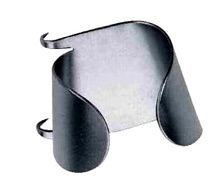
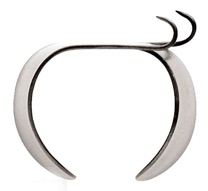
Fig 12
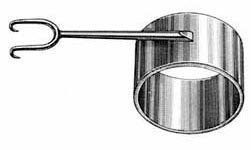
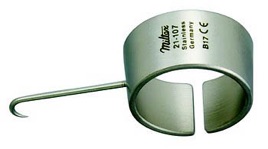
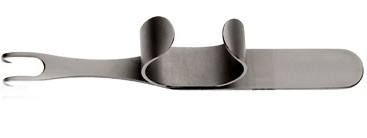
Fig 13
General Surgery
In a course of lectures on Surgical diseases at La Charité Hospital, Paris in 1842 (7), Professor Velpeau discussed his method of ligating varicose veins. In his technique the trunk of the vein was raised up with the fingers and a pin was passed below the ends of the fingernails and underneath the vein. The finger was protected from the pin with a thimble. A ligature was wound round the pin and drawn tight. This simple process was repeated for every dilated vein so that between eight and fifteen pins may have been required between the ankle and the knee. The ligatures and pins were not removed for up to 12 days when the vein had become necrotic. If the eschar had not detached by this time it was removed. Professor Velpeau wrote that ‘the introduction of the pins gives very little pain but the constriction exercised by the ligature is excessively painful.’ ‘No dressing is required after this operation. You have merely to cut short the ends of the pins, to prevent them from pricking the patient.’ Professor Velpeau claimed to have used this method in both private and public practice but was unable to tell ‘how often it has been performed’! He claimed to have had only one fatality following the procedure.
In 1921 Sir W. I. De C. Wheeler, Vice-President, Royal College of Surgeons, Ireland, reported that a thimble (8) was ‘of great assistance in making a suprapubic opening for drainage in cases of septic peritonitis.’ ‘Before the primary wound is closed, the finger guarded with the thimble is introduced into the abdomen and seeks the interval between the recti muscles just above the pubes. With the thimble as a guide a stab wound is rapidly made, dividing all the tissues down to the peritoneum. The latter is pushed forward and is opened by a nick of a sharp-pointed knife between the bars carrying the round knob. A drainage tube (Keith's glass tube for preference) is fitted to the top of the thimble and is guided with great ease to the bottom of Douglas's pouch’ (Fig 14). ‘If the unguarded finger is used as a guide, the peritoneum stretches itself over the rubber glove and it is troublesome to separate one from the other.
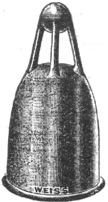

Fig 14
Surgeons must avoid cutting too boldly on an unguarded finger in the presence of septic peritonitis.’ This same technique has been used for draining axillary abscesses following mastectomy and fashioning stomata in colorectal surgery. In 1938 (9) the same technique was described using an ‘ordinary sewing thimble’.
More recently surgeons operating in deep cavities may use the index finger of the non-dominant hand to guide the tip of a needle into the correct position. During this process the guiding finger may be injured. Accidental finger stick injuries may also occur in normal suturing, and occasionally an injury may result from a scalpel during dissection. The advent of HIV infection and the various forms of hepatitis have made such needle or knife stick injuries particularly significant so that not only do surgeons wear two pairs of gloves but some surgeons also wear a simple thimble on the index finger under the glove. Recently a more complex form of this type of ‘thimble’ has been described (Fig 15). It is worn outside of the glove and held in place with a malleable handle.
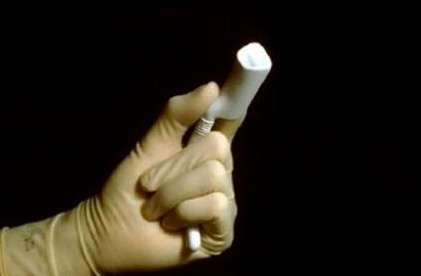
Fig 15
Another use of a thimble, this time modified with a ‘pushing rod’ may be used to facilitate knot tying in a deep cavity where there may not be enough room to tie a normal knot. In this case the first throw of the knot is tied outside the cavity and then, using a ‘pusher’, slid down one of the suture ends until tight. The next throw is similarly tied and then pushed down to tighten. This process is facilitated by the thimble pusher but there are many other simple pushing devices in use too, so that the thimble ‘pusher’ has never really been very popular.
Obstetrics
In 1875 Gordon described an ‘Obstetric thimble’ for rupturing the membranes (10). The thimble, which fits the index finger, had a sharp point which curved over the free edge of the nail and which facilitated the rupture the membranes.
In cases of obstructed labour, with a dead foetus, it may be necessary to decapitate the foetus to facilitate vaginal delivery. A special thimble has been devised to allow encircling of the foetal neck with a wire saw (Blond Haidler saw). The saw has ball ends and the thimble has a small opening in one side with a hole at its end (Fig 16). The saw ball is inserted into the opening in the thimble and the thimble is worn by the accoucheur. The thimble-bearing finger is introduced into the vagina and passed around the foetal neck. The saw handles are attached after removal of the thimble.

Fig 16
In 1903 a coca butter and cocaine ‘thimble’ (11) was used to rapidly dilate the cervical os during the first stage of labour.
Ophthalmology
Ophthalmologists have used a thimble with an extension (Fig 17) in conjunction with a head mounted indirect ophthalmoscope, and hand held lens, for examination of the peripheral retina at the root of the iris, where most retinal holes, leading to retinal detachment, occur. Instillation of local anaesthetic was necessary prior to performance of the procedure in conscious patients. The technique does not seem to have been very widely used and the special thimbles are very uncommon.
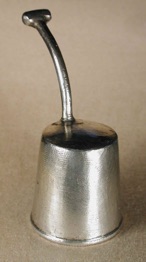
Fig 17
Orthopaedic Surgery
In the 30s Nordenbos (12) used fibular bone to stabilise femoral neck fractures in much the same way as Kuntscher nails were used later. In order to prevent shattering of the graft as it was being hammered into the drilled out track between the greater trochanter and the femoral head, a thimble was used over the end to prevent splitting.
Thimble splints have been used to immobilise fractures when the fracture itself is confined to the distal phalanx (13). A plaster-of-Paris thimble enclosing the whole digit provides adequate immobilization. Aluminum thimbles called ‘thimble splints’ have also been used for this purpose (Fig 18).
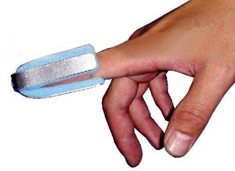
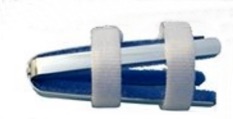
Fig 18
Plastic surgery
Plastic surgical procedures on the breast often involve extensive finger dissection to separate the breast tissue from the surrounding structures and a thimble has been devised to facilitate this process.
Urology
Thimbles have been used in order to fix the testes in the scrotum following surgery for undescended testis. Once the undescended testes have been mobilised and placed in the scrotum they must be kept in place until healing has taken place otherwise they may retract again. Usually a loop suture is placed in tissue adjoining the testis and brought out through scrotal skin. So as not to have the tied suture cut through the scrotal skin, the suture is tied over something more substantial. Special buttons, pieces of rolled gauze, etc., or even thimbles have been used in this way.
Dental surgery
John Q Adams Vl of Richmond, in 1971, patented (3696821) a pair of thimbles to facilitate the use of dental floss (Fig 19). The thimbles clamped the floss to the fingers by friction thus avoiding the need to wrap the floss around the fingertips. Floss was held in a container and fed between the finger and thimble and out through an aperture in the top of the thimble.

Fig 19
Music
Banjo players sometimes used to wear a thimble on the first finger for ‘stroke’ or ‘thimble’ playing. The thimble (Fig 21) was usually made of German silver and should not be thick or heavy. According to S.S. Stewarts Banjo and Guitar Journal in 1887, ‘In playing marches, etc., the entire execution is nearly always done with the thimble; that is, nearly all the notes are struck with the thimble, and the thumb is little used…’ but ‘In playing jigs, walk arounds, etc., and other music of the old style, common a few years ago, the thumb has as much to do as the first finger...’
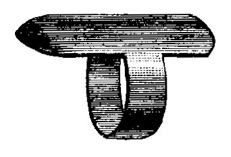
Fig 20
Another type of thimble was used for banjo playing in the 19th century. It was called the ‘Californian Thimble’ (Fig 21), similar to a tailor’s thimble, but how it was used was not known to the Journal.
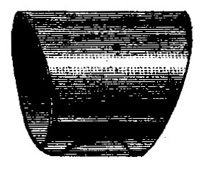
Fig 21
Office
Clerks used to wear rubber thimbles for sorting papers to facilitate a good and accurate grip (Fig 22). In the present electronic age the use of paper in offices has been largely replaced by digital storage and thus the use of the rubber thimble has virtually ended and such thimbles are rather difficult to find now.

Fig 22
Wig making
Wigmakers who hand made and knotted hairs individually used a wigmakers thimble to protect their third finger when sewing the foundation of the wig (Fig 23).

Fig 23
A wig makers tools consisted of a small hammer, a pair of pliers, a crochet hook and a special thimble (Fig 24).
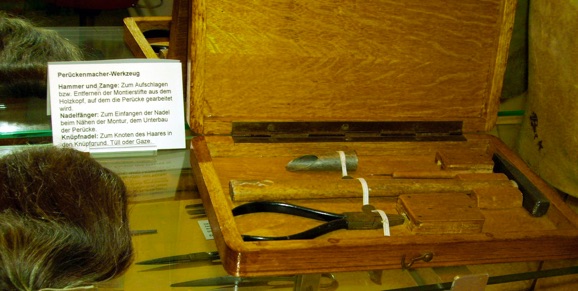
Conclusion
Surprisingly there are quite a number of non-needlework related uses of thimbles ranging from music to medicine. It could be argued that some of the medical thimbles are used for something to do with sewing but many do not. The other uses really have nothing to do with sewing at all.
References
1. McConnel B. The Thimble Society of London magazine, 1993; 4 (12): 4
2. O’Donovan WJ. Discussion of occupational dermatitis. BMJ 1922: 2: 502
3. McConnel B. The story of the thimble. Atglen, PA. Schiffer Publishing Ltd, 1997. pp. 126.
4. Harrison E. Some hints on time saving in operations. BMJ 1916; 1: 645
5. Glenn WWL. Mitral Valvulotomy. Ann. Surg., 1957; 145: 557.
6. Cresswell Baber E. Thimbles for making wool mops. BMJ 1906; 2: 432
7. Velpeau AALM. Course of clinical lectures on surgical diseases. BMJ 1842; 1: 483
8. De C. Wheeler WI. A Device to Assist in the Introduction of a Pelvic Drain. BMJ 1931; 1: 975
9. Coulson TE. Drainage of Pelvic abscess in acute appendicitis. BMJ 1938; 2: 789
10. Gordon D. A new kind of midwifery forceps; and an obstetric thimble for rupturing the membranes. BMJ 1875; 1: 231
11. Atkins SE. Cocaine in parturition. BMJ 1909; 1: 356
12. Kilvington B. Fibular grafts in fractures of the neck of the femur. Cited BMJ 1933; 1: 41
13. Taylor GN. Treatment of the fractured great toe. BMJ 1943; 2: 724
British Medical Journal - Christmas 2012: Yesterday’s World. Surgical thimbles.
http://bmj.com/cgi/content/full/bmj.e8447?ijkey=ZBtC3y8ugMzP6Ca&keytype=ref
Holmes: 'Thimbles for Other Uses' pp. 232.
Researched and published in 2002/12
Copyright@2011. All Rights Reserved
Magdalena and William Isbister, Moosbach, Germany
non-sewing or quilting thimbles
Navigation
